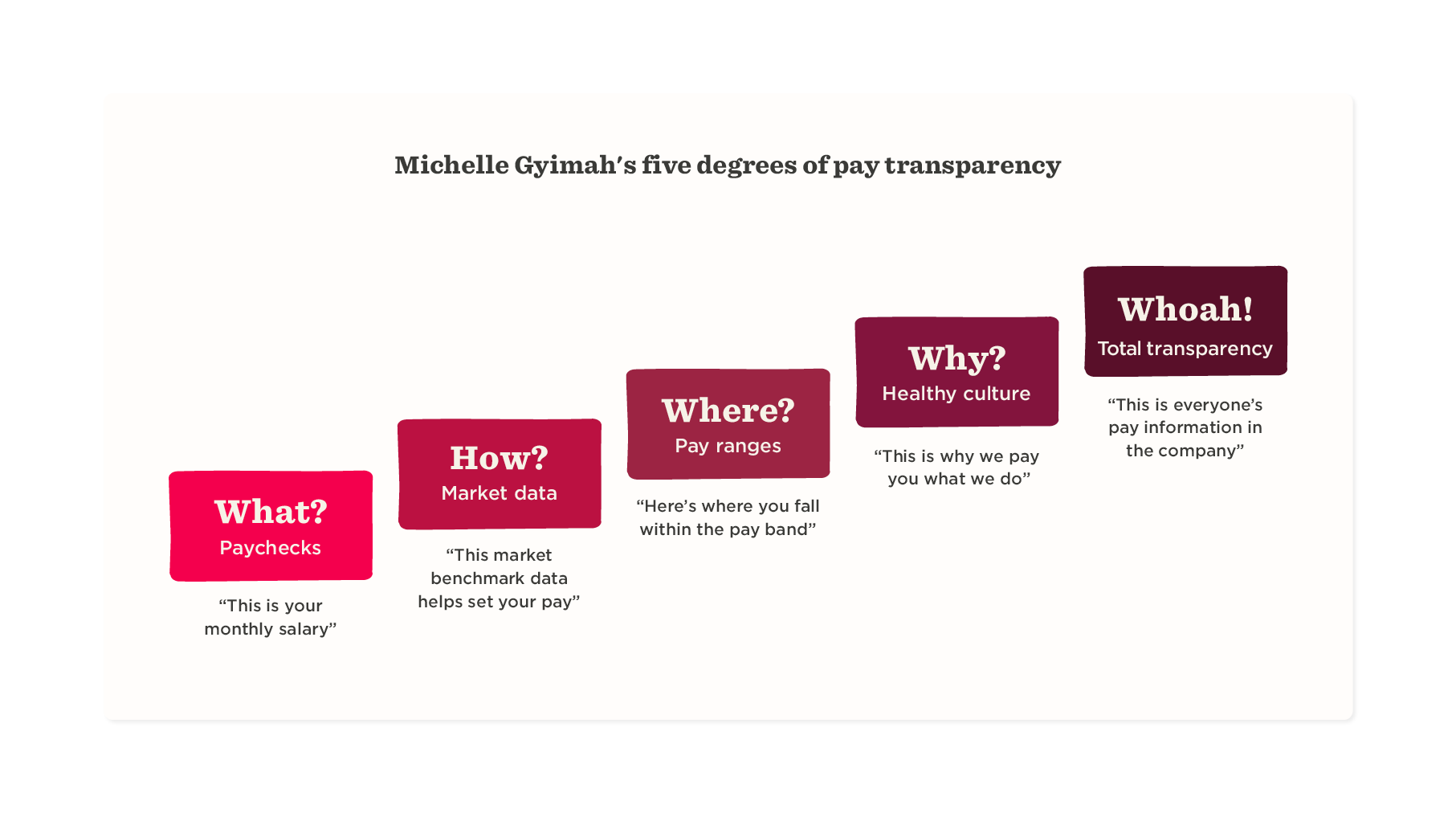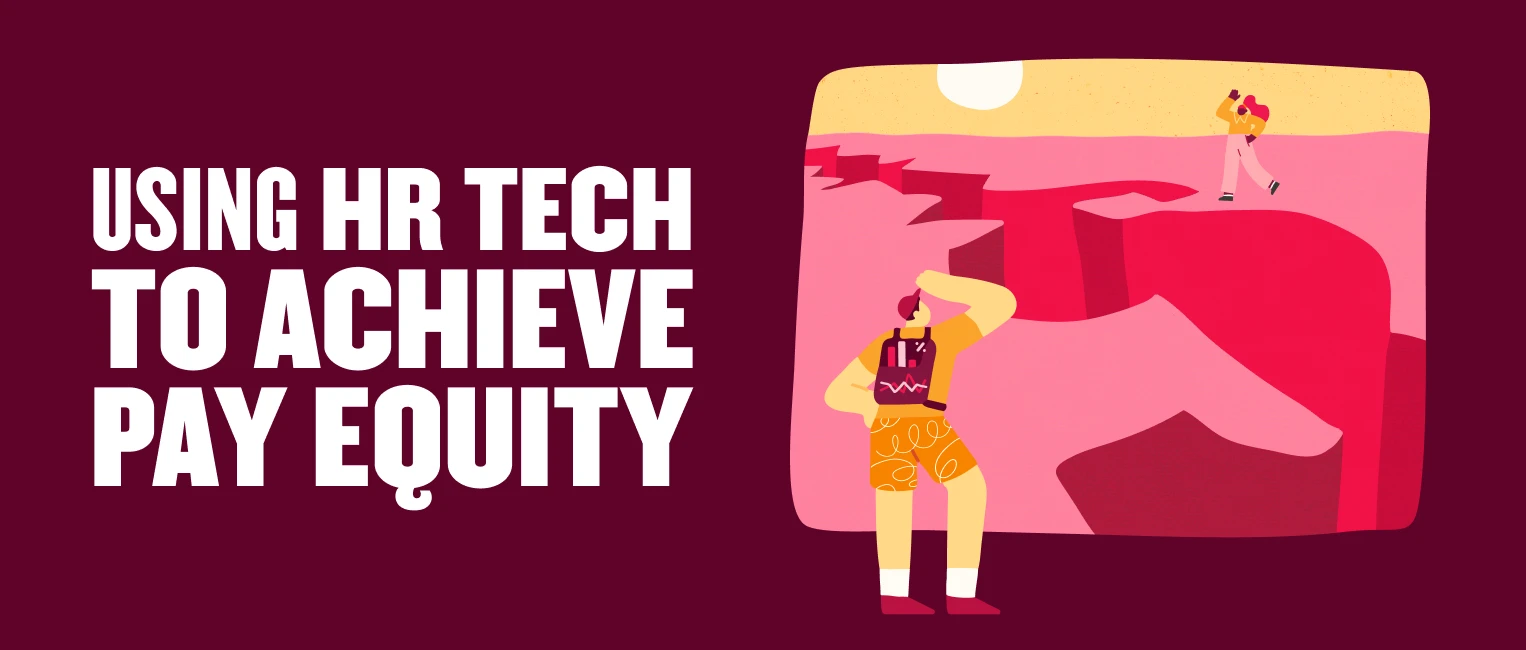Modern companies have made huge strides to improve their people’s experiences and establish core values of transparency and fairness.
Buffer, the social media management company, openly shares its team’s salaries in a publicly accessible spreadsheet. Salesforce publicly discloses its pay equity findings and regularly analyzes pay disparities based on gender and race. Newer companies like FairComp provide tools and data to help employees get paid fairly.
The gender pay gap is getting narrower, but at a glacial pace as shown by this 2024 Payscale survey.
Let’s take a closer look at pay transparency, and why it’s so important for achieving pay equity.
The importance of pay equity in the modern world of work
First, let’s define what we mean by pay equality, pay equity, and pay transparency.
Pay equality means every person is paid the same, regardless of their performance or qualifications.
Pay equity refers to individuals receiving fair and equal pay for work of equal value, regardless of gender, ethnicity, age, or other protected characteristics.
Pay transparency is the practice of openly sharing information about compensation in the pursuit of pay equity, allowing people to understand how their pay compares to others and promoting fairness in the workplace.
Unfortunately, pay transparency is often misunderstood. Many people—including business leaders—often conflate pay equity with pay transparency, mistakenly thinking it’s just about being open about pay bands for different roles at their company or posting salary ranges to job ads.
HR leaders have the power to clarify the difference between pay equity and transparency for the C-suite (and other decision-makers) and win their support for more progressive initiatives.
Pay transparency is a powerful tool to fight pay inequality
Around the world, many countries have introduced different laws and pieces of legislation to encourage and enforce transparency in the workplace. Here are just a few examples:
United States
The US has various laws and regulatory bodies that address pay equity and transparency, which often differ between states:
- The Equal Pay Act (1963) is a federal law that prohibits gender-based pay discrimination
- Title VII of the Civil Rights Act (1964) prohibits pay discrimination based on race, religion, sex, or national origin
- The National Labor Relations Act (1935) protects a person’s right to discuss their pay and working conditions with others
- The Office of Federal Contract Compliance Programs (OFCCP) enforces regulations that require non-discrimination, including equal pay for people working in the public sector
Several US states have introduced their own pay laws. For instance, California, New York, Massachusetts, and others have specific laws addressing pay transparency and equity. As of June 2023, “more than 25% of US workers are covered under pay transparency laws.” This figure is fast approaching 50 percent as more states and municipalities continue to introduce new legislation.
Some US states and cities also have pay transparency laws that require employers to:
- Provide salary information to job applicants
- Disclose pay scales
- Prohibit salary history inquiries during the hiring process
United Kingdom
The Equality Act 2010 (Gender Pay Gap Information) Regulations 2017 requires organizations with 250 or more people to report on their gender pay gaps, including mean and median gender pay gaps, the proportion of men and women distributed across their pay structure, and bonus pay gaps. The regulations also prohibit pay discrimination on the basis of gender, ensuring equal pay for equal work.
European Union
The EU adopted the Pay Transparency Directive in 2023. The directive aims to eliminate pay discrimination and narrow the gender pay gap across its member countries and includes regulations regarding:
- Access to information. Job advertisements must now include pay scales or salary ranges.
- Annual reports. Companies with over 250 people must submit reports on gender pay gaps with information on average pay levels to the national authorities every year.
- Salary history disclosure. Companies cannot legally ask job applicants about their salary histories.
- Employee compensation. If a pay report indicates pay discrimination, companies are obliged to compensate any affected individuals.
- Intersectional pay discrimination is prohibited.
Australia
Australia’s laws and regulations to promote pay equity and transparency include:
- The Fair Work Act (2009) includes provisions for equal remuneration, promoting pay equity for work of equal value, and prohibiting gender-based pay discrimination
- The Workplace Gender Equality Act (2012) requires organizations to report on gender equality indicators, including gender pay gaps
- The Fair Work Commission reviews and approves workplace agreements, ensuring employers comply with relevant laws, including pay equity
- The Fair Work Ombudsman provides resources to help organizations and their people understand their rights regarding pay, including equal remuneration
Australia’s Fair Work Legislation Amendment (Secure Jobs, Better Pay) Act 2022 also prohibits pay secrecy clauses in employment contracts, allowing people to discuss their pay with colleagues.
In addition, Australia passed the Workplace Gender Equality Amendment (Closing the Gender Pay Gap) Bill (WGEA) in 2023, which requires companies with over 100 employees to publish their gender pay metrics and report them to their boards and governing shareholders. Companies with more than 500 people will also be required to report various gender equality indicators to the government, including their company’s gender composition, gender pay gap ratio, and rates of discrimination and sexual harassment.
The five degrees of pay transparency
As well as the different laws and legislation surrounding pay transparency, there are many other ways to improve pay transparency in your organization.
One example is the “five degrees of pay transparency” framework, coined by pay gap expert Michelle Gyimah. She explains that you can use the framework to assess your organization’s position regarding pay transparency and where improvements can be made.
Gyimah stresses that pay transparency is actually a spectrum and suggests breaking it down into five points:
- What: Tell your people how much they’ll get paid every month
- How: Share market data to help people see where they fall compared to others
- Where: Create a compensation plan with a breakdown of salary, salary benefits, and the cost of a whole benefits system, along with a specific pay range for each person
- Why: Establish clear processes on how pay is decided
- Whoah: Provide a totally transparent pay system, where everyone has access to everyone else’s salary

Leverage HR tech to achieve pay transparency and equity
Today, 45 percent of senior HR leaders “struggle to access the relevant data needed to correct pay equity gaps.” That’s why investment in HR tech is critical—to get a full picture of your people and their pay. Here are just a few things HR tech can do for you:
Conduct a pay equity audit (PEA) to find outliers and make things right
A pay equity audit (PEA) compares the salaries of people doing similar work. Any pay differences that can’t be explained by criteria like work experience or job performance need further scrutiny. But there’s a ton of data to dig through.
This is where HR tech can help cut through the noise, automate data collection, and provide accurate insights into what it all means for your organization.
HR professionals can leverage the power of HCMs (or HRIS) to easily sort through this information. HR tech is here to help you quickly identify team members whose pay falls outside equitable ranges. The tech can also provide HR teams with clear and accurate views into people’s time at the company, their job role, promotion history, and performance reviews.
An HCM can also provide you with a macroscopic view into how well you’re meeting your pay equity goals across the entire company and different departments according to team demographics, location, and more.
Track key pay equity metrics
HR platforms make it easy to track specific metrics to ensure all people are getting the same opportunities to advance, regardless of age, race, or gender. These metrics can include:
- Salary range penetration. Every job description in an organization should come with an estimated salary range that reflects the position’s standard pay to reveal pay gaps.
- Salary average and salary change. “Salary average” compares the average salaries of two groups of people, while “salary change” compares how salaries have changed over a given period. Investigating these metrics against different demographics can identify existing parities in your organization.
- Career path ratio. This allows HR to keep track of promotions and lateral moves to see how people are growing, changing, and adapting within your organization, while also ensuring you stay compliant with local regulations.
Ensure compliance across regions
Using data and continuous tracking from your HR tech, you can maintain compliance with local laws across all your sites. As compliance laws can vary by region, you’ll need to consider how this might differ between countries.
Increase employee satisfaction and your EVP
With HR tech, it’s easier than ever to track your people’s job satisfaction and your EVP.
And there’s a trend—more companies introducing increased pay transparency measures are already seeing promising results.
For instance, fair compensation increases job satisfaction—simply because it helps people feel that they are properly valued by the company for their time and expertise.
Research from Mercer also found that pay transparency is intrinsically linked to retention, with one study finding that people who feel they are paid fairly are 85 percent more engaged and 62 percent more committed than those who don’t feel they are paid fairly.
And when it comes to recruiting new people, research by SHRM found that 70 percent of organizations that list pay ranges in job advertisements said it has led to more people applying for their jobs, while 66 percent said it has increased the quality of applicants.
Listing pay ranges also helps companies overcome proximity bias—for example, by comparing the salaries of people who work in the office versus those who work from home. This provides more visibility into remote and hybrid team members’ compensation, and how it chalks up to their office-based colleagues.
Building pay transparency into your company culture
To fully incorporate pay transparency into your culture so that every member of your team experiences and benefits from it, there are a number of strategies you can use:
Familiarize yourself with relevant pay transparency laws
Get to know the pay transparency laws relevant to your country. This is particularly essential in the US, where there may be state- and city-specific regulations. Then, use these laws as the foundation for your core compensation philosophy.
Create a comprehensive pay audit and salary structure
Leverage internal and external compensation benchmarking data, along with salary surveys, to identify and address pay gaps and inconsistencies. Use these insights to create an equitable salary structure for your company, grouping pay bands into a cohesive company-wide framework.
Recommended For Further Reading
Keep track and adjust
Introduce a continuous monitoring and adjustment process, measuring the effectiveness of your pay philosophy and salary structure through regular pay audits. This will help you maintain open communication with your people, and stay informed about the latest salary benchmarks and pay gap data to make necessary adjustments.
HR has the power to shift the conversation around pay
There are plenty of ways to improve your pay transparency in your efforts to achieve pay equity—and there are many benefits to doing so. With the right HR tech to help you spot trends and gaps, you have the power to change your company’s pay equity for the better and improve your overall satisfaction and retention metrics for years to come.


